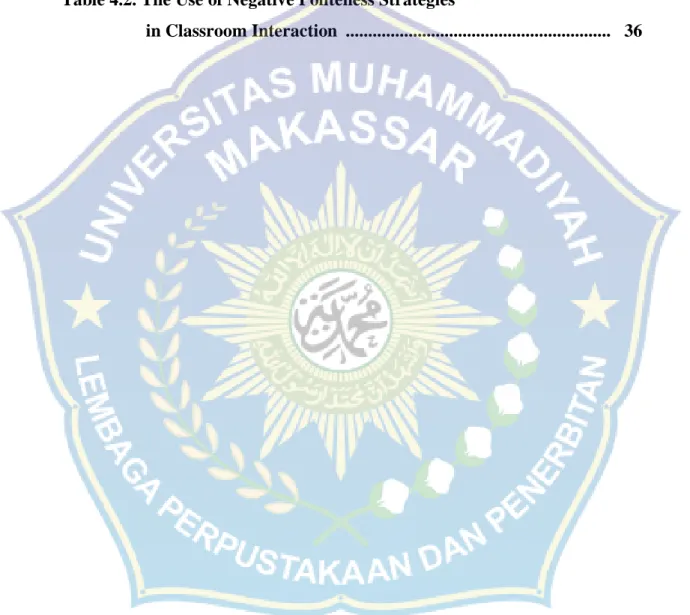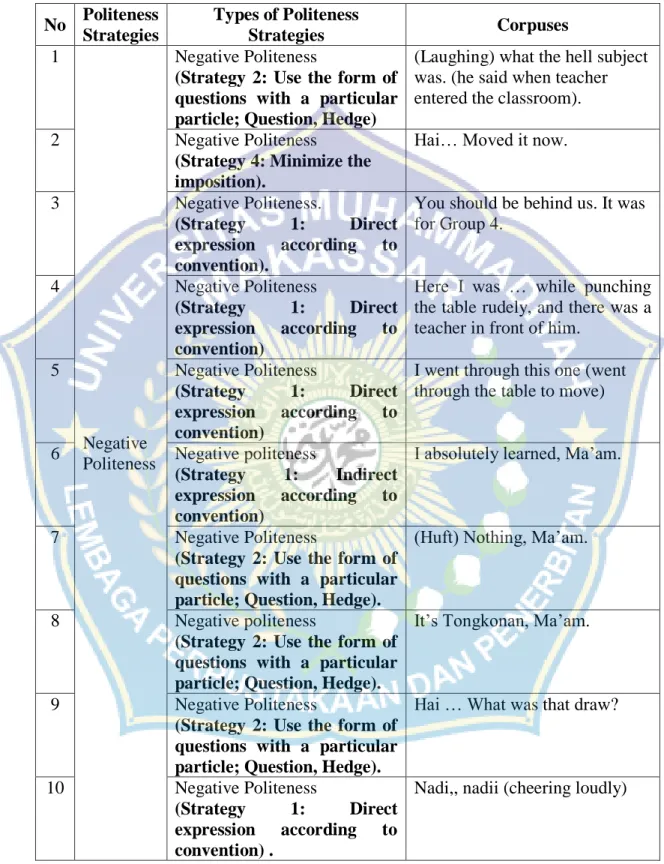The researcher applied descriptive qualitative research to better understand the phenomena of students' behavior strategies. The researcher focused on the observation of X IPA students in SMA YP PGRI 3 MAKASSAR. The researcher made a classroom observation and observation checklist that used classroom etiquette strategies.
Principal, teachers, staff and X IPA students of SMA YP PGRI 3 Makassar who helped the researcher during the research.
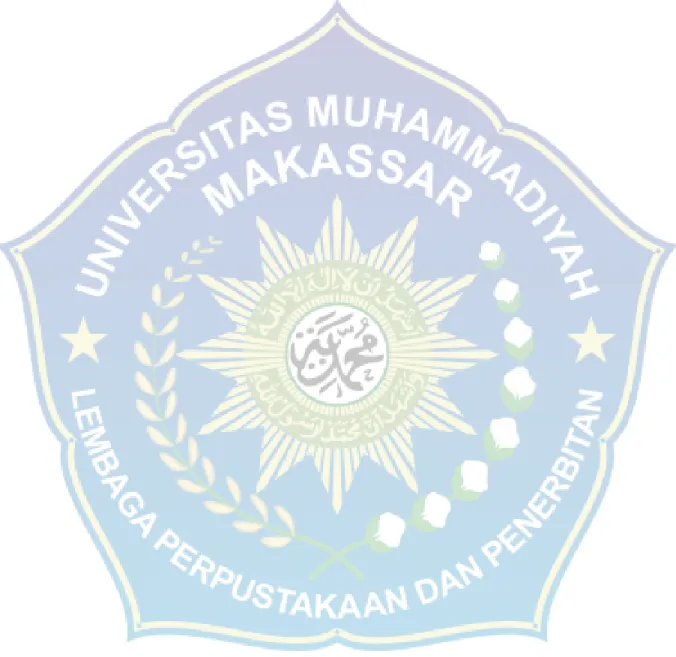
INTRODUCTION
- BACKGROUND
- PROBLEM OF THE RESEARCH
- OBJECTIVE OF THE RESEARCH
- SIGNIFICANCE OF THE RESEARCH
- SCOPE OF THE RESEARCH
Arising from the description above, the researcher is interested in conducting a research titled "An Analysis of Students' Politeness Strategies in Classroom Interaction". Theoretically, the research findings were expected to enrich the understanding and understanding of pragmatic learning, especially about politeness strategies. Practically, this research will provide an additional reference to the study of pragmatics, especially on politeness strategies in the context of family conversation.
It specifies for an analysis of students' politeness strategies which was limited to find out the positive and negative politeness strategies used by students of SMA PGRI 3 Makassar in ELT classroom interaction.
REVIEW OF RELATED LITERATURE
REVIEW OF RELATED RESEARCH FINDINGS
It turned out that politeness strategies were often used in interaction, and this research had an effect on communication as a whole. An analysis of politeness strategies used by teachers and students in English class at MTs NU Assalam Kudus. It was clearly revealed that politeness strategies always occur in the interaction and can influence people in choosing politeness strategies based on the factors.
The factors influencing the different politeness strategies consist of social distance, relative power, and the ranking of imposition.
SOME PERTINENT IDEAS
Geyer summarizes four different views of politeness based on Frasers (1990) classification: “social norm”. "conversational contract", "conversational maxim" and "saving face". Positive politeness strategies are used to reduce the distance between the speaker and the listener and to reduce the listener's frustration by expressing kindness. They offer fifteen strategies, namely observing, exaggerating, heightened interest, using group identity markers, seeking consensus, avoiding disagreement, assuming, joking, caring about the listener's wishes, offering or promising, showing optimism, involving the speaker and the listener in the activity, giving reasons, it offers reciprocal action and gives sympathy.
This strategy can be realized in the form of giving special attention to the hearer (giving special attention to the hearer (H)). From the above statement it appears that the speaker expressed his interest excessively in relation to the other, with the aim of reducing the disappointment of said opponents. One way of indicating that speaker and hearer are working together, and thus possibly putting pressure on the hearer to cooperate with the speaker, is to assert or imply knowledge of the hearer's wishes, and a willingness to to suit your own requirements.
Related to that statement, in addition to positive politeness above, Brown and Levinson also classified a number of negative politeness strategies to reduce violations of the hearer's negative face. This strategy corrects the hearer's negative face by explicitly expressing doubt that the condition for appropriateness of the speaker's speech act exists. There are two sides to the coin in the realization of reverence: one in which the speaker humbles and humbles himself and another in which the speaker elevates the hearer (gives him a positive face of a certain kind, namely that which satisfies the hearer's will to be treated as superior ).
By apologizing for performing face-threatening acts (FTAs), the speaker may indicate his reluctance to hit the hearer's negative face and thereby partially redress that violation. In this strategy, the FTA is carried out “[…] in the most direct, clear, unambiguous and concise way possible” (Brown and Levinson in Bousfield, 2008: 57). Bald recording does nothing to minimize threats to the listener's "face". Here, there is no attempt to accept the wishes of the listener's face.
He usually tries to reduce the distance between them by expressing a kind statement and a firm interest in the listener's needs.
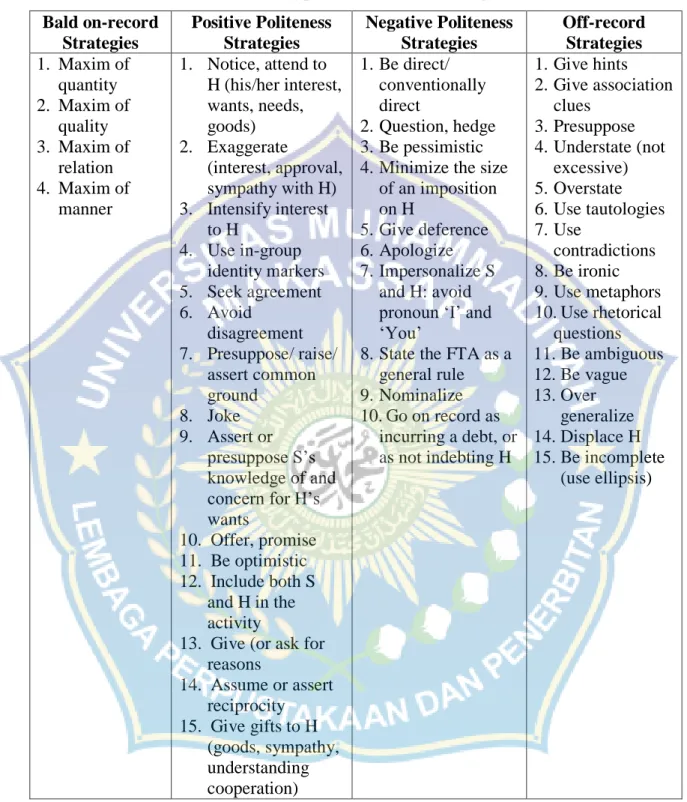
CONCEPTUAL FRAMEWORK
Then it can be an important factor for cognitive development, educational results of students and new social skills. So students will establish social relationships through this kind of interaction, where the sense of learning community is promoted and isolation is reduced in the classroom. The study was started by observing the classroom situation to make a list of the classroom interaction.
After the list of classroom interactions was established, the study then defined each list into the types of politeness strategies based on the characteristics of the politeness strategies. Each type of politeness strategies will then be grouped into the same characteristics of each type; These are positive politeness and negative politeness.
RESEARCH METHOD
- RESEARCH DESIGN
- SUBJECT OF THE RESEARCH
- FOCUS OF THE RESEARCH
- INSTRUMENT OF THE RESEARCH
- PROCEDURE OF COLLECTING DATA
- TECHNIQUE OF DATA ANALYSIS
The researcher discovered the positive politeness strategies of notification, paying attention to H (his/her interests, wants, needs, goods), using identity markers within the group, seeking agreement, avoiding disagreements, assuming/advising/asserting a common point of view, Offer or promise and give (or ask for reasons). The transcription of the recording was used to determine what kind of politeness strategies the students used during the study. From the tables above, the researcher identified and classified the types of politeness strategies of students using the utterances.
The researcher found 20 statements that use politeness strategies that consist of positive and negative politeness. The following extract presents how students' politeness strategies emerged and the factors that influenced different strategies in classroom interaction. It deals with the types of student politeness strategies of students at SMA YP PGRI 3 MAKASSAR in classroom interaction.
Regarding students' politeness strategies, this study dealt with the types that influence students' politeness strategies in classroom interaction. All students greeted the teacher by saying "good morning, mom." the extract above showed that students used positive politeness. The researcher found that the students performed two politeness strategies; these are positive politeness and negative politeness strategies to answer the teacher's instruction, question or friend comment.
Analisis strategi kesantunan yang digunakan tokoh-tokoh dalam The Ugly Truth. 6 Kesopanan Negatif Pertama Langsung ke sini bu (naik ke meja untuk melanjutkan) 7 Kesopanan Positif Pertama Selesai Bu.
FINDINGS AND DISCUSSIONS
FINDINGS
Calling "Mom" could be categorized as a positive politeness that the students positioned themselves as children. It was one of the rebellious students who was playing telephone (in the first meeting), and the student deeply appreciated the teacher who was teaching inside, so he reprimanded his friend who was playing telephone, but in a polite way and it belongs to the category of positive politeness. . And by that time the lesson (first meeting) was over and the teacher tells the students to finish at home and gather at the next meeting and a student very politely answers "yes mom" he belongs to the category of "Positive Politeness".
The student (second meeting) was grateful as her teacher praises herself "thank you mam". Thank you is one of "positive politeness". Rude and understated utterances, which were conveyed by the student (Ss5) categorized as negative politeness. It can be seen that the student (Ss5) only used personal marker “weee” and “ko” which categorized as negative politeness.
Excerpt thirteen (first meeting) was similar to the third excerpt, using impolite personal marker “cow” categorized as negative politeness to convey the teacher's instruction. It can be categorized as negative politeness where verbal and physical responses were rude and impolite. The rude verbal and physical responses were rude and could be categorized as negative politeness.
A very disrespectful tone, which was not good for hearing, was said by a student (Ss17) with “huuuhhh”, like shouting, and falls under the category of negative politeness. A student wants to call his classmate (second meeting), but he calls him very rudely and disturbs the calm of the class very much, "Nadi, Nadi", this category includes "negative politeness".
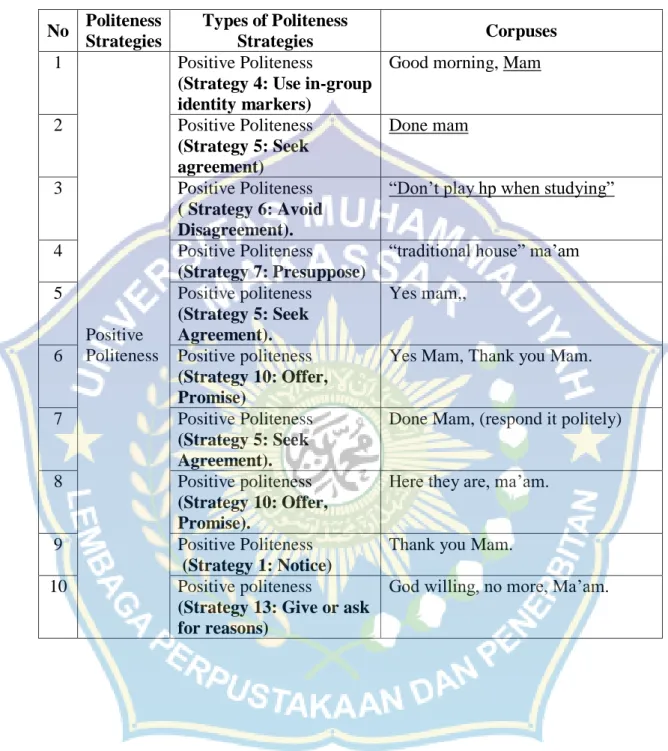
DISCUSSIONS
The students used this type to show their politeness and minimize the distance between speaker and listener and to reduce the listener's disappointment by expressing kindness. The students used this type to convey their opinion but the word. negative' here does not mean 'bad', it is just the opposite of pole of. As it was mentioned in chapter 1, the purpose of this research is to find out the types of politeness that are taken are 20 statements that used politeness strategies.
In the classroom interaction, the students used different types of politeness strategies to have a good conversation; the students try to establish good communication by using politeness strategies. The students should consider politeness as an important aspect of the student's character building when interacting in the classroom. The researcher also gives a suggestion to the next researcher to use the other theory of politeness and it may be politeness strategies in speech where the theory of lack of is used to understand more about the implicit meaning of the speaker.
Selain peneliti mengetahui apa yang dimaksud dengan penelitian, maka peneliti tertarik untuk mempelajari strategi kesantunan, oleh karena itu disarankan juga untuk mengetahui strategi yang lebih lanjut. 2 Kesopanan Negatif Pertama Hahaha, pelajaran yang luar biasa. dia tidak menghargai guru memasuki kelas). Pindah tempat ko cepat 4 Kesopanan Negatif Pertama Dibelakangmu!, Kelompok 4 ada 5 Kesopanan Negatif Pertama Di sinilah aku, (sambil memukul meja dengan keras, dan di depannya ada guru).
11 Etiket Pertama Positif Rumah Adat Mam 12 Etiket Negatif Pertama Tongkonan Toh Mam, 13 Etiket Positif Pertama Ya Mam,. 18 Detik Santunan Positif Insya Allah Tidak Ada Bunda, 19 Detik Santunan Negatif Wah, apa daya tariknya.
CONCLUSIONS AND SUGGESTIONS
CONCLUSIONS
Based on the findings and discussions in the preceding chapter, the researcher comes to the following conclusion.
SUGGESTIONS
The association of reverence with linguistic form,” International Journal of the Sociology of Language Freser, B.
Observation Checklist
The Video Transcript (meeting 1)
Ss14 : di sinilah aku (sambil memukul meja dengan keras) (dan guru di depannya). tidakkah aku menyadarinya tadi ibu". Ss9 : langsung lewat sini aku akan. naik ke atas meja untuk melangkah ke bangku berikutnya). Pertanyaan: Mohon minta 1 orang perwakilan per kelompok untuk membaca teks di buku cetakan. Ss20 : Saya tidak tahu cara membaca, Bu.
Apa yang kamu mainkan di belakang, ini ponselmu, jangan gunakan ponselmu di kelasku.
The Video Transcript (meeting 2)
The Subject of The Research
Documentations
Documents
